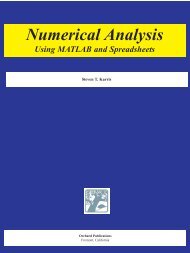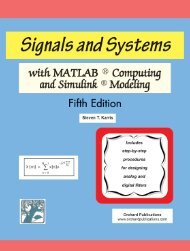endof-
Signals & Systems Front Cover FOURTH.qxp - Orchard Publications
Signals & Systems Front Cover FOURTH.qxp - Orchard Publications
You also want an ePaper? Increase the reach of your titles
YUMPU automatically turns print PDFs into web optimized ePapers that Google loves.
Properties and Theorems of the Z Transform∞⎧⎫Yz ( ) = Z ⎨ ∑xm [ ]hn [ – m]⎬ =⎩⎭m = 0∞∑n = 0∞∑m = 0xm [ ]hn [ – m]z – nand interchanging the order of the summation, we obtain∞∑∞∑Yz ( ) = xm [ ]hn [ – m]z – n =m = 0n = 0∞∑m = 0∞∑xm [ ] hn [ – m]n = 0z – nNext, we let k = n–m, then, n = k + m, and thus,or∞Yz ( ) =∑xm [ ]∑hk [ ] z –( k + m)=m = 0∞n = 0Yz ( ) = Xz ( ) ⋅ Hz ( )∞∑m = 0∞∑xm [ ]z – m hk [ ]n = 0z – k(9.27)9.2.10 Convolution in the Discrete−Frequency DomainIf f 1 [ n] and f 2 [ n] are two sequences with Z transforms F 1 ( z) and F 2 ( z)respectively, then,f 1[ n] ⋅ f 2 [ n]∫°1z⇔ -------- xF 1 ( v)F 2--j2π⎝ ⎛ v⎠⎞ v – 1dv(9.28)where v is a dummy variable, and is a closed contour inside the overlap convergence regionsfor X 1 ( v) and X 2 ( z ⁄ v). The proof requires contour integration; it will not be provided here.9.2.11 Initial Value Theorem∫°Proof:For all n ≥ 1, as z → ∞f [ 0] = lim Xz ( )z nz → ∞– = ----1 → 0z n(9.29)and under these conditions f[ n]z – n → 0 also. Taking the limit as z → ∞ in∞∑Fz ( ) = f[ n]z – nn = 0Signals and Systems with MATLAB ® Computing and Simulink ® Modeling, Fourth EditionCopyright © Orchard Publications9−9







